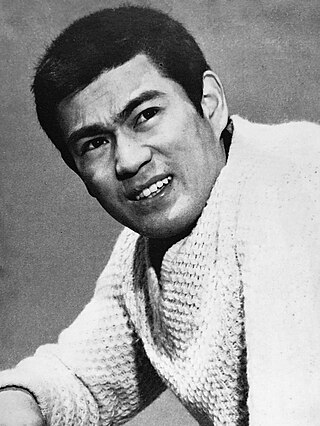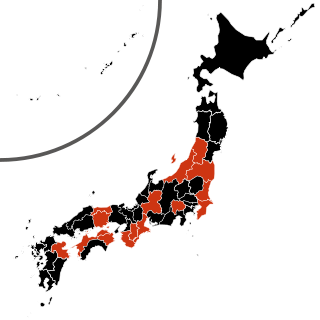
Shinichi Chiba, known internationally as Sonny Chiba, was a Japanese actor and martial artist. Chiba was one of the first actors to achieve stardom through his skills in martial arts, initially in Japan and later before an international audience.

Shigeru Omi is the President of the Japan Community Health Care Organization. He previously served as Regional Director of the Western Pacific Regional Office for the World Health Organization. He has been a member of the World Health Organization Executive Board since 2013.

Jun Matsumoto is a Japanese politician of the Liberal Democratic Party, a member of the House of Representatives in the Diet.

Takashi Ōtsuka is a Japanese politician of the Liberal Democratic Party, a member of the House of Representatives in the Diet. A native of Osaka and graduate of Otemon Gakuin University, he was elected to the House of Representatives for the first time in 2005 after an unsuccessful run in 2003. He is affiliated to the revisionist lobby Nippon Kaigi.

The 2009 Japan flu pandemic was an outbreak of the H1N1 and the Influenza A viruses across Japan. The World Health Organization raised the pandemic alert for influenza to level 4 in April 2009 following a worldwide outbreak of the H1N1 influenza strain. The first Japanese infections of H1N1 and Influenza A were both recorded early in May 2009. In August 2009, the government estimated that the virus strains had infected about 760,000 people. At the height of the pandemic in October 2009, it was estimated that 20% of the Japanese population had been infected and that there were on average more than 20 infected people in each Japanese medical facility. The Ministry of Health, Labor and Welfare reported 198 Deaths as of March 30, 2010. Japan put several measures in place to attempt to control the spread of infection including quarantining air travellers entering Japan who were suspected of having the virus and closing schools in areas of Japan with high numbers of infection. The pandemic ended in August 2010 when the World Health Organization announced that worldwide influenza infection number were back to the seasonal average before the outbreak occurred.
Alissa Yagi, also known as Arisa Yagi, is a Japanese actress and model associated with Amuse, Inc. From 2008 to 2012, Yagi was an exclusive model for the pre-teen fashion magazine Nicola. Since 2012, she modeled exclusively for the magazine Vivi, and in 2014, she made her acting debut as Megumi Kitagawa in the live-action film adaptation of Say I Love You.
Fumiya Sankai is a Japanese vlogger, actor, recording artist and influencer in the Philippines. He has been active in his YouTube Channel, FumiShun Base, since 2015. His fame grew when he became the first pure Japanese official housemate in Pinoy Big Brother: Otso, a reality TV show for Filipinos. The "Konnichi-Wonder Vlogger ng Japan", as he is called, Fumiya finished the 9-month running show as the 5th big placer.

The COVID-19 pandemic in Japan has resulted in 33,803,572 confirmed cases of COVID-19 and 74,694 deaths, along with 33,728,878 recoveries.

The Diamond Princess is a British-registered luxury cruise ship that is operated by Princess Cruises, a holiday company based in the United States and Bermuda. In February 2020, during a cruise of the Western Pacific, cases of COVID-19 were detected on board. The vessel was quarantined off Japan for two weeks, after which all remaining passengers and crew were evacuated. Of the 3,711 people on board, 712 became infected with the virus – 567 of 2,666 passengers, and 145 of 1,045 crew. Figures for total deaths vary from early to later assessments, and because of difficulties in establishing causation. As many as 14 are reported to have died with the virus, all of them older passengers – an overall mortality rate for those infected of 2%.
Novel Coronavirus Expert Meeting is a Japanese advisory body established in the New Coronavirus Infectious Diseases Control Headquarters of the Japanese Cabinet.
Kanon Shizaki is a Japanese voice actress and musician who is currently freelance and was previously affiliated with Ace Crew Entertainment. She plays the keyboard for the band Roselia of the BanG Dream! franchise, which includes portraying the character Rinko Shirokane. She also was the keyboardist for the unit Happy Around! of D4DJ, where she voiced Rei Togetsu until 2022.

Sherry Moi Meng Ling is a Malaysian virologist, currently serving as a professor at the Graduate School of Medicine, the University of Tokyo. Her research focuses on innate immune system to mosquito-borne virus infection and field epidemiology.

Arakurayama Sengen Park is a block park located at 3353 Arakura, Fujiyoshida, Yamanashi Prefecture, Japan. Installed in October 1959. Located on the hillside of Mount Arakura, it covers an area of about 4.3 hectares.
The following are the events in professional sumo during 2022.
Saisaki-mode (幸先詣) referred to the practice of visiting shrines and temples earlier than usual for Hatsumōde in 2021 during the third wave of the COVID-19 pandemic. This practice aimed to avoid the usual crowds of worshippers and the resultant difficulties in maintaining social distancing. The concept was first proposed by a shrine in Fukuoka Prefecture and subsequently encouraged by the Fukuoka Prefecture Shrine Agency.

Voreas Hokkaido is a men's volleyball club in Japan. It currently plays in V.League Division 2. This club is located in Asahikawa city, Hokkaido.
The 2022 Emperor's Cup and Empress' Cup All Japan Volleyball Championship was the 16th edition of Emperor's Cup and Empress' Cup All Japan Volleyball Championship. The final round of the tournament was held from 9–18 December 2022.

Shikoku AquariumThe Japanese public aquarium is located in Utazu, Kagawa Prefecture. The aquarium is accredited as a Museum-equivalent facilities by the Museum Act from Ministry of Education, Culture, Sports, Science and Technology.















